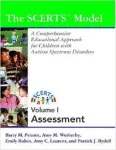| Titre : |
The SCERTSÂŪ Model. A Comprehensive Educational Approach for Children with Autism Spectrum Disorders : Volume 1 : Assessment |
| Type de document : |
texte imprimÃĐ |
| Auteurs : |
Barry M. PRIZANT, Auteur ; Amy M. WETHERBY, Auteur ; Emily RUBIN, Auteur ; Amy C. LAURENT, Auteur ; Patrick J. RYDELL, Auteur |
| Editeur : |
Baltimore [Etats-Unis] : Brookes Publishing |
| AnnÃĐe de publication : |
2006 |
| Importance : |
334 p. |
| Format : |
21,5cm x 28cm x 1,7cm |
| ISBN/ISSN/EAN : |
978-1-55766-689-5 |
| Note gÃĐnÃĐrale : |
Bibliogr. |
| Langues : |
Anglais (eng) |
| Mots-clÃĐs : |
SCERTS Model (Social Communication Emotional Regulation and Transactional Supports) |
| Index. dÃĐcimale : |
APP-D APP-D - Interventions Educatives - Généralités |
| RÃĐsumÃĐ : |
A groundbreaking synthesis of developmental, relationship-based, and skill-based approaches, The SCERTSÂŪ Model provides a framework for improving communication and social-emotional abilities in preschool and primary school students with autism spectrum disorders (ASD) and their families. Developed by internationally recognized experts, SCERTSÂŪ supports developmental progress in three areas: Social Communication (communicating spontaneously and establishing relationships), Emotional Regulation (regulating emotional arousal to support learning and engagement), and Transactional Supports (elements that aid a child's progress as he or she works toward a goal).
With the two-volume manual set, early intervention professionals will have comprehensive and practical guidance on using SCERTSÂŪ in assessment and intervention.
Volume I: Assessment gives detailed background information on The SCERTSÂŪ Model and guides professionals through the assessment process. Early interventionists will examine the research foundations and the recommended practices that inform the model; learn about specific goals and objectives for each of the three SCERTSÂŪ components; get a detailed listing of developmental milestones that contribute to the recommended assessment and intervention plans; explore The SCERTSÂŪe; Model's similarities and differences with other models; and discover how to use the model in educational settings. Assessment report and observation forms are included to help collect information and monitor child progress. [RÃĐsumÃĐ d'Auteur/Editeur] |
| Permalink : |
https://www.cra-rhone-alpes.org/cid/opac_css/index.php?lvl=notice_display&id=285 |
The SCERTSÂŪ Model. A Comprehensive Educational Approach for Children with Autism Spectrum Disorders : Volume 1 : Assessment [texte imprimÃĐ] / Barry M. PRIZANT, Auteur ; Amy M. WETHERBY, Auteur ; Emily RUBIN, Auteur ; Amy C. LAURENT, Auteur ; Patrick J. RYDELL, Auteur . - Baltimore [Etats-Unis] : Brookes Publishing, 2006 . - 334 p. ; 21,5cm x 28cm x 1,7cm. ISBN : 978-1-55766-689-5 Bibliogr. Langues : Anglais ( eng)
| Mots-clÃĐs : |
SCERTS Model (Social Communication Emotional Regulation and Transactional Supports) |
| Index. dÃĐcimale : |
APP-D APP-D - Interventions Educatives - Généralités |
| RÃĐsumÃĐ : |
A groundbreaking synthesis of developmental, relationship-based, and skill-based approaches, The SCERTSÂŪ Model provides a framework for improving communication and social-emotional abilities in preschool and primary school students with autism spectrum disorders (ASD) and their families. Developed by internationally recognized experts, SCERTSÂŪ supports developmental progress in three areas: Social Communication (communicating spontaneously and establishing relationships), Emotional Regulation (regulating emotional arousal to support learning and engagement), and Transactional Supports (elements that aid a child's progress as he or she works toward a goal).
With the two-volume manual set, early intervention professionals will have comprehensive and practical guidance on using SCERTSÂŪ in assessment and intervention.
Volume I: Assessment gives detailed background information on The SCERTSÂŪ Model and guides professionals through the assessment process. Early interventionists will examine the research foundations and the recommended practices that inform the model; learn about specific goals and objectives for each of the three SCERTSÂŪ components; get a detailed listing of developmental milestones that contribute to the recommended assessment and intervention plans; explore The SCERTSÂŪe; Model's similarities and differences with other models; and discover how to use the model in educational settings. Assessment report and observation forms are included to help collect information and monitor child progress. [RÃĐsumÃĐ d'Auteur/Editeur] |
| Permalink : |
https://www.cra-rhone-alpes.org/cid/opac_css/index.php?lvl=notice_display&id=285 |
|  |

